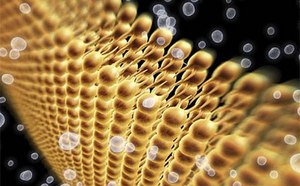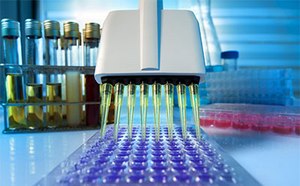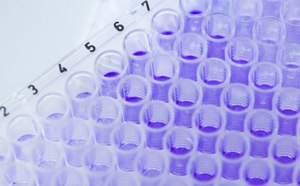Metabolomics Research

Metabolomics is the comprehensive study of metabolites, or the small molecule substrates, intermediates and products of metabolism, within cells, biofluids, tissues, or organisms. These unique chemical fingerprints are left behind by cellular processes. Metabolomics research provides a biochemical synopsis of a biological system and the physiological impact of disease, nutrition, therapy, or genetic modifications on an organism.
Featured Categories
Explore high-quality lipids for empowering innovation in lipidomics, drug delivery, and...
We offer a broad range of metabolism assay kits for the convenient and dependable analysis of metabolites and enzymes for all your research applications.
We provide small molecule metabolite libraries and kits with a comprehensive range of primary metabolite compounds covering key metabolic pathways for your metabolomics research.
ISOTEC® Stable Isotopes are useful for tracer studies in proteomics and metabolomics, agents for MRI / MRS, and in a wide range of other biomedical applications.
Applications of Metabolomics
Metabolomics, with its wide-ranging applications, significantly influences pharmaceutical research by identifying disease biomarkers and assessing personalized medicine's toxicity. In functional genomics integration, it plays a pivotal role in predicting gene function by studying interactions among the genome, transcriptome, proteome, and metabolome. Microbial mining benefits from metabolomic insights for enhanced strain optimization, while plant metabolomics advances agriculture biotechnology through the study of plant metabolites. Environmental research employs metabolomics to test pollutant effects and optimize biofuel production, while nutritional research utilizes metabolomics for assessing nutrition levels and ensuring food safety.
Understanding Metabolites and the Metablome
The interaction of metabolites within a biological system is referred to as the metabolome. The metabolome is the complete set of metabolites in an organism or biological sample. Metabolites are compounds with low molecular weight, generally less than 1.5 KDa, which are the intermediates or products of biosynthesis/catabolism pathways. Examples include amino acids, nucleotides, carbohydrates, and lipids, which are often studied separately in lipidomics research. Primary metabolites are endogenous and directly involved in normal growth, development, and reproduction. Secondary metabolites are exogenous and not involved in these processes but have important ecological functions.
Metabolomic Pathways and Analytical Techniques
Metabolomic pathways are investigated utilizing metabolites, enzymes, separation tools, and metabolite analysis and labeling. Two common metabolic profiling techniques are targeted and untargeted metabolomic analyses. Targeted analysis quantifies specific known metabolites, while untargeted analysis provides the global metabolic profile for both known and unknown metabolites. Metabolic fingerprinting is a rapid, global analysis without the intention of specifically identifying each metabolite.
Metabolomics Workflow and Analytical Methods
A metabolomics workflow involves an integrated approach of sample preparation, standardization, calibration, separation methods, detection of metabolites, and data analysis. Common sample types include plasma, urine, saliva, tissue, and cells. Separation methods such as gas chromatography (GC), high-performance liquid chromatography (HPLC), or capillary electrophoresis (CE) are paired with detection methods like mass spectrometry (MS). Analytical techniques commonly used in metabolite detection include MS, nuclear magnetic resonance (NMR), Fourier transform infrared (FT-IR) spectroscopy, and Raman spectroscopy. Sophisticated tools and software are required for metabolomics data analysis, ensuring stringent compound identification and quantification, and accurate data interpretation.
Visit our document search for data sheets, certificates and technical documentation.
Related Articles
- Cholesterol biosynthesis starts in the hepatic endoplasmic reticulum with acetyl-CoA, yielding 3-hydroxy-3-methylglutaryl-CoA via HMG-CoA synthase.
- Uncover properties and applications of the cysteine protease papain and find inhibitors, substrates, and other papain products.
- UHPLC separation of Vitamin D Metabolites using Supel™ Carbon LC column ensures excellent peak shape and sensitivity.
- LC-MS/MS method quantifies similar polar nucleotide activated sugars using Supel™ Carbon LC column for simultaneous analysis.
- An RP-LC×RP-LC-PDA-MS method for the metabolic profiling of G. glabra extract using the MSG approach for enhanced metabolic coverage.
- See All (57)
Related Protocols
- Lipopolysaccharides (LPS) are characteristic components of the cell wall of Gram negative bacteria; they are not found in Gram positive bacteria.
- Follow our procedure for the determination of alpha-Amylase activity. This enzymatic assay of a-Amylase guides you through the entire process and necessary calculations.
- Enzymatic Assay of Acid Phosphatase (EC 3.1.3.2)
- To measure alcohol dehydrogenase activity, this assay uses β-nicotinamide adenine dinucleotide phosphate and a continuous spectrophotometric rate determination at 340 nm.
- To standardize an enzymatic assay procedure of cellulase.
- See All (15)
Find More Articles and Protocols
How Can We Help
In case of any questions, please submit a customer support request
or talk to our customer service team:
Email custserv@sial.com
or call +1 (800) 244-1173
Additional Support
- Chromatogram Search
Use the Chromatogram Search to identify unknown compounds in your sample.
- Calculators & Apps
Web Toolbox - science research tools and resources for analytical chemistry, life science, chemical synthesis and materials science.
- Customer Support Request
Customer support including help with orders, products, accounts, and website technical issues.
- FAQ
Explore our Frequently Asked Questions for answers to commonly asked questions about our products and services.
To continue reading please sign in or create an account.
Don't Have An Account?



